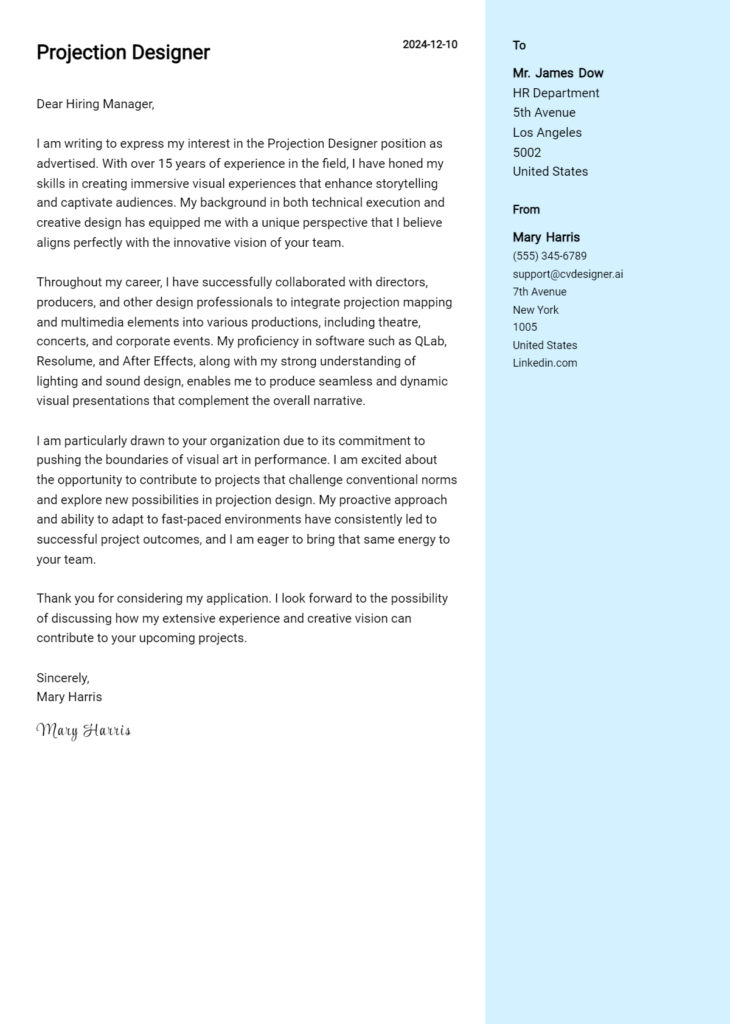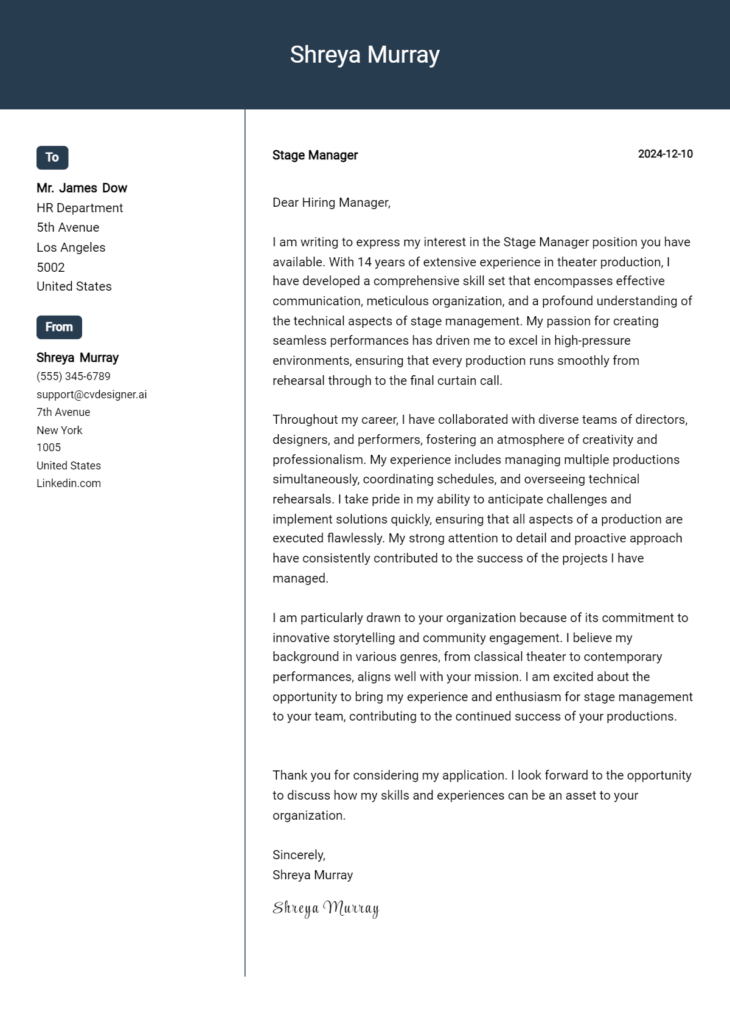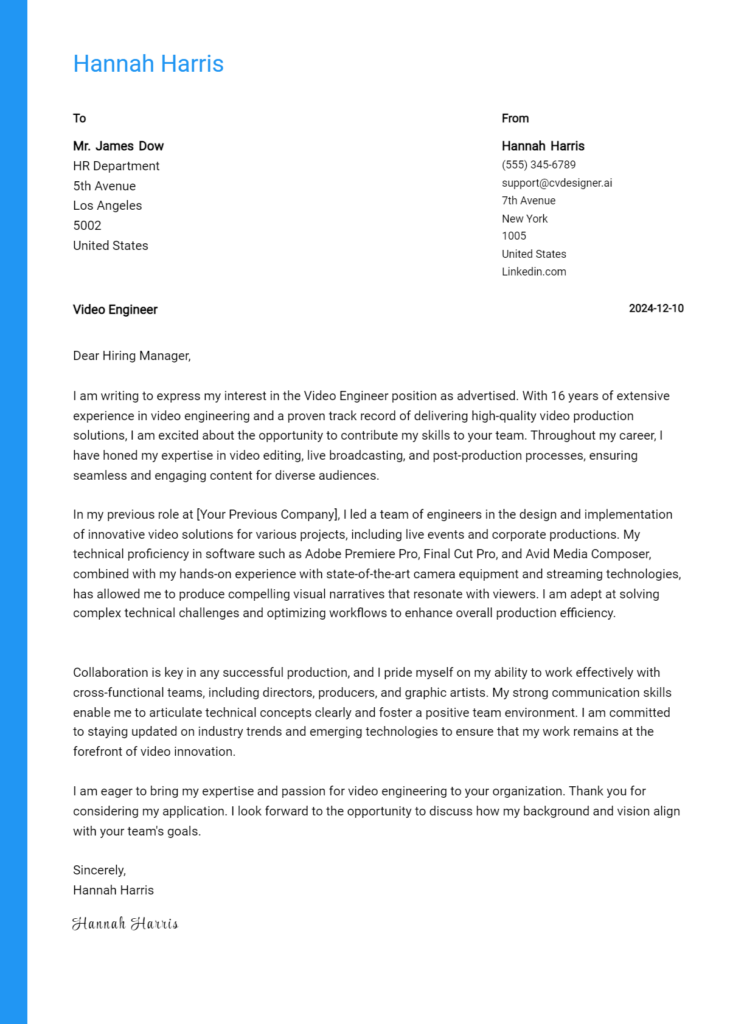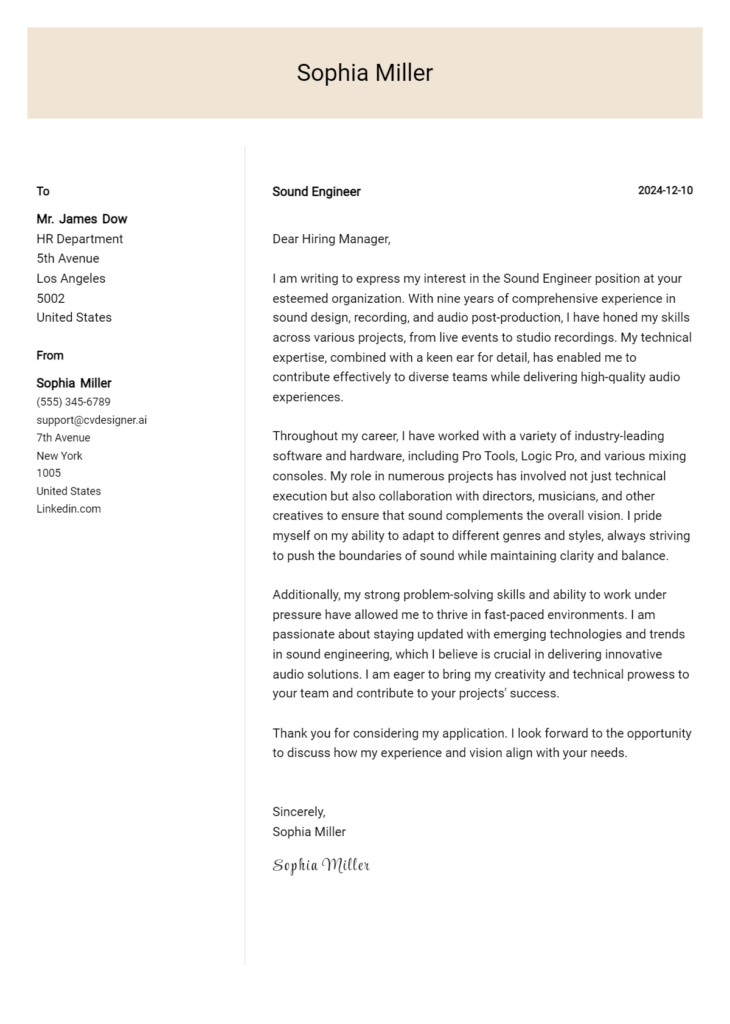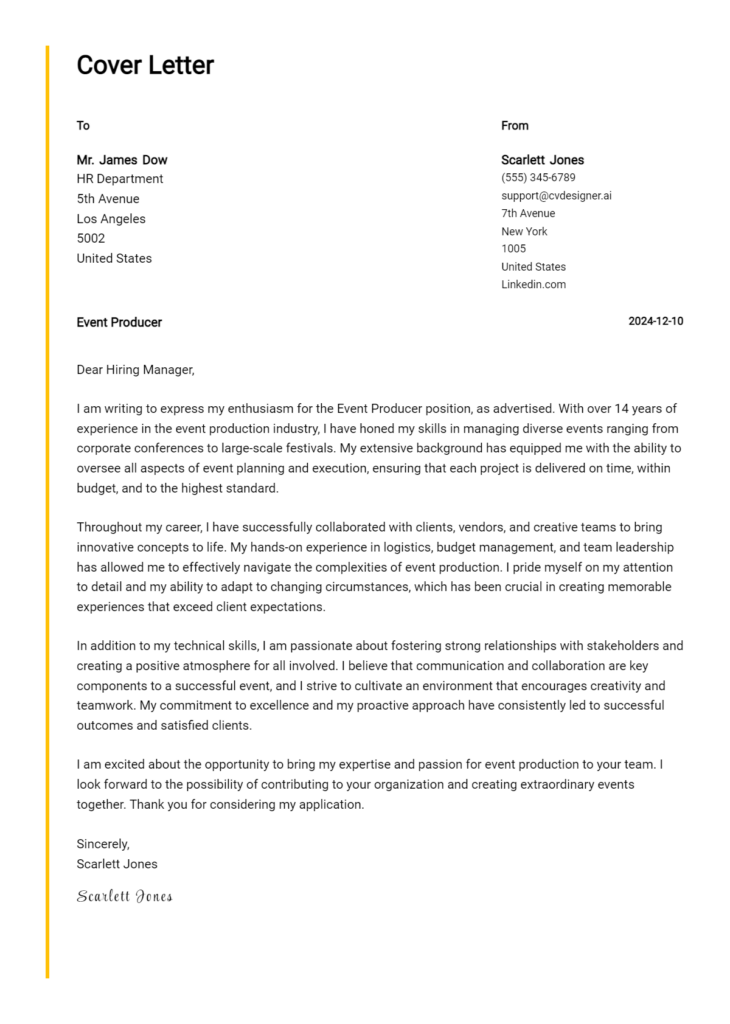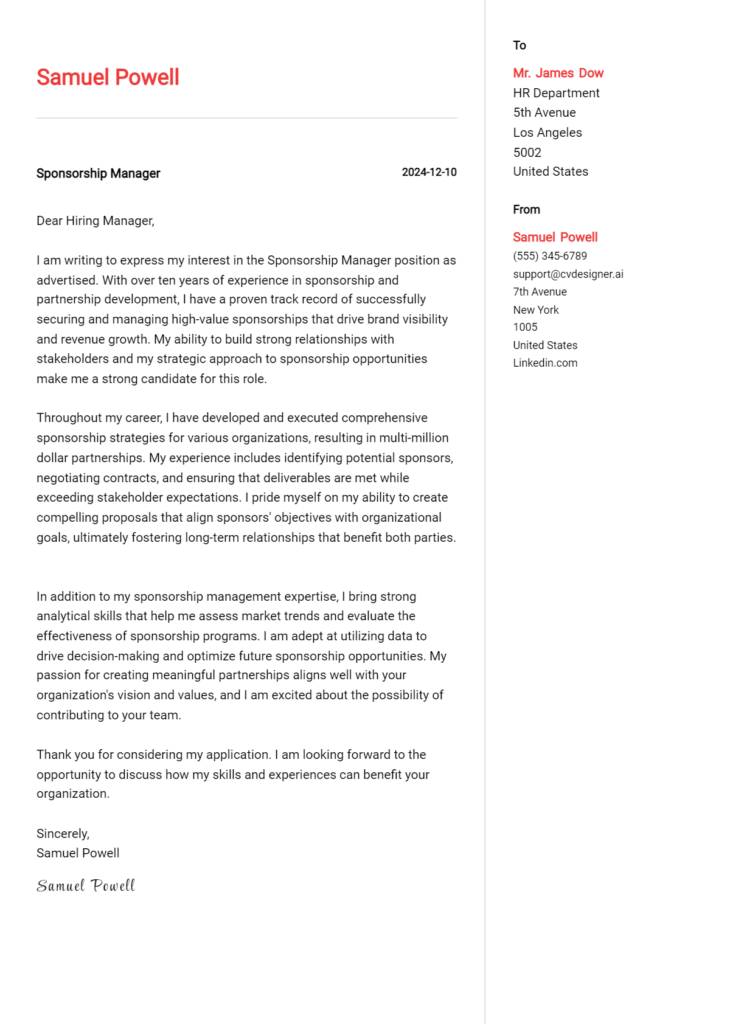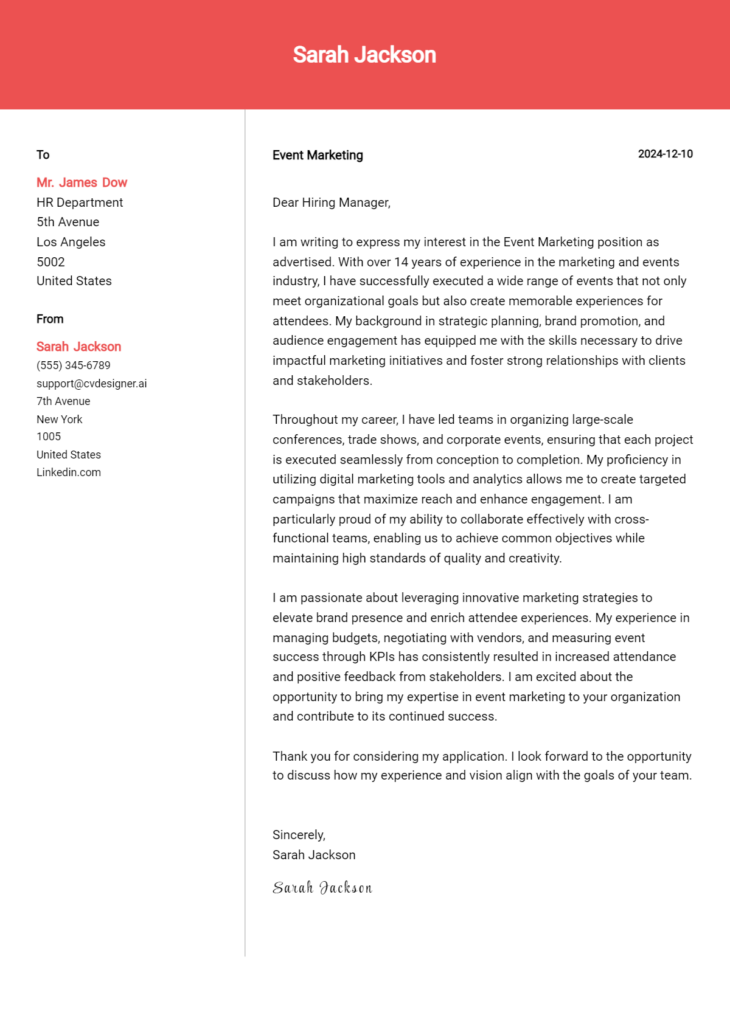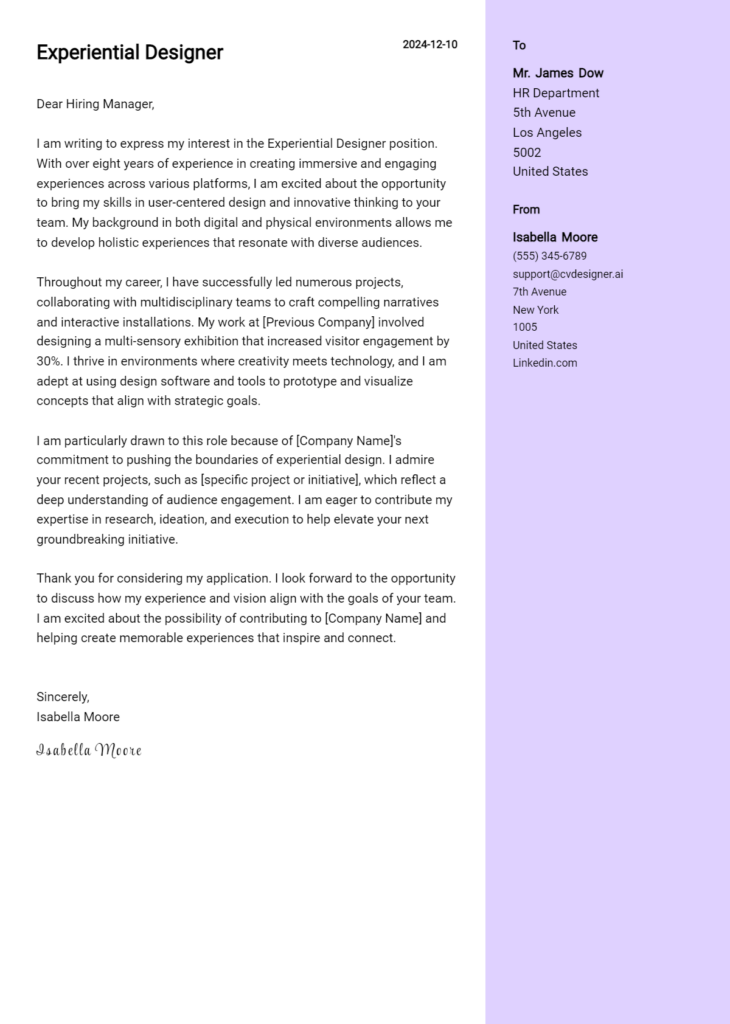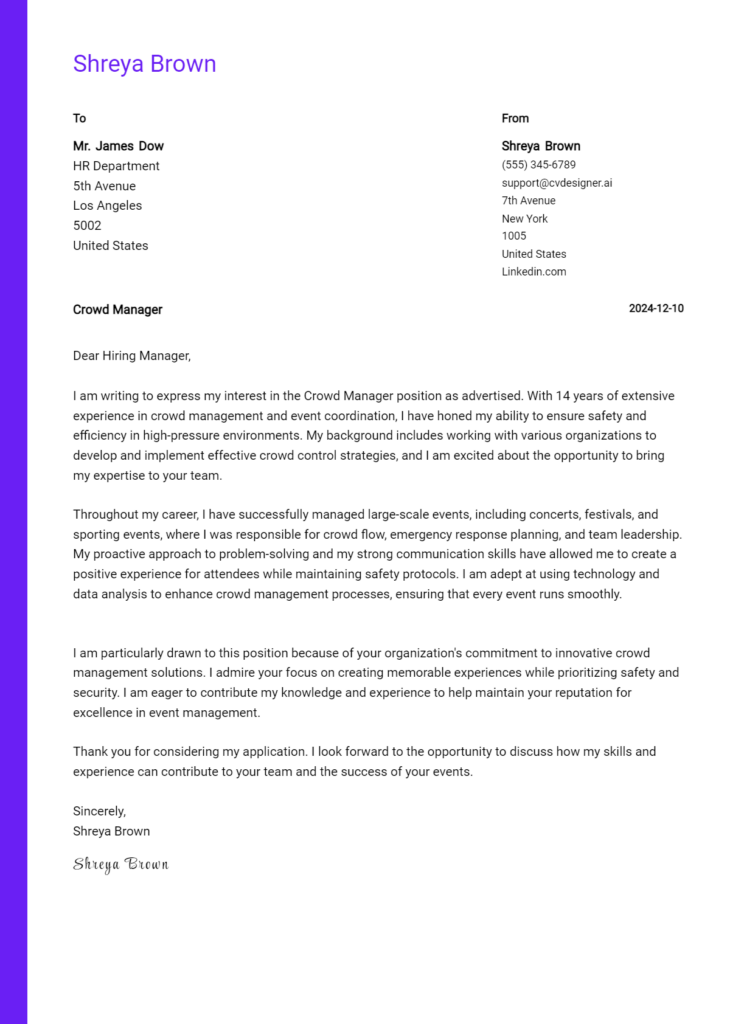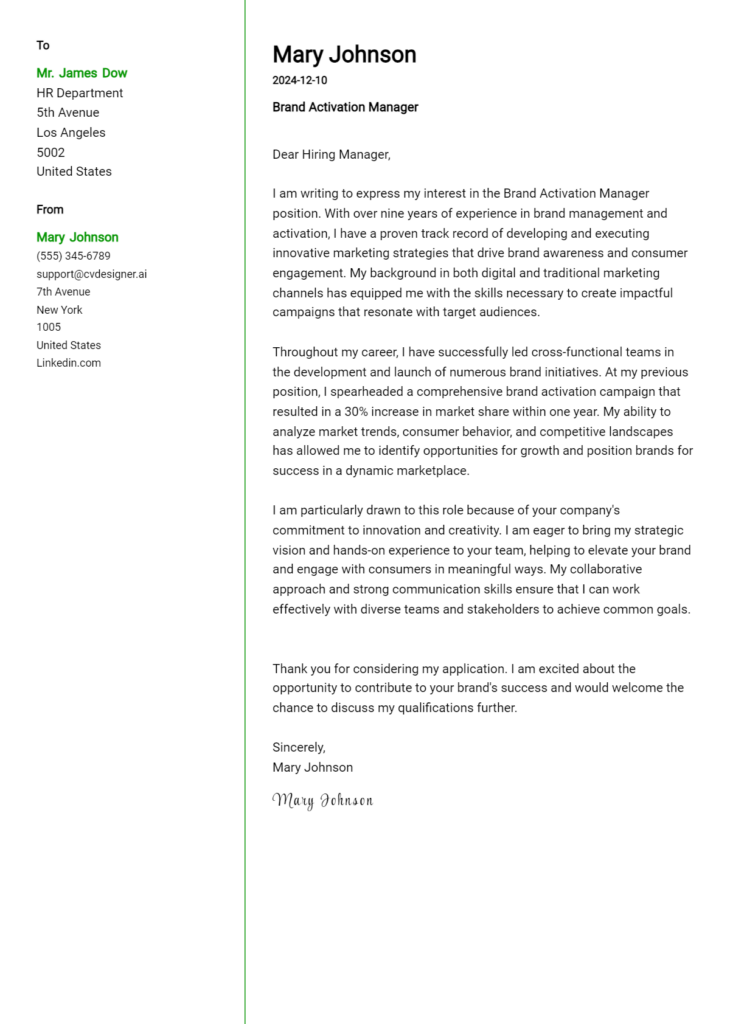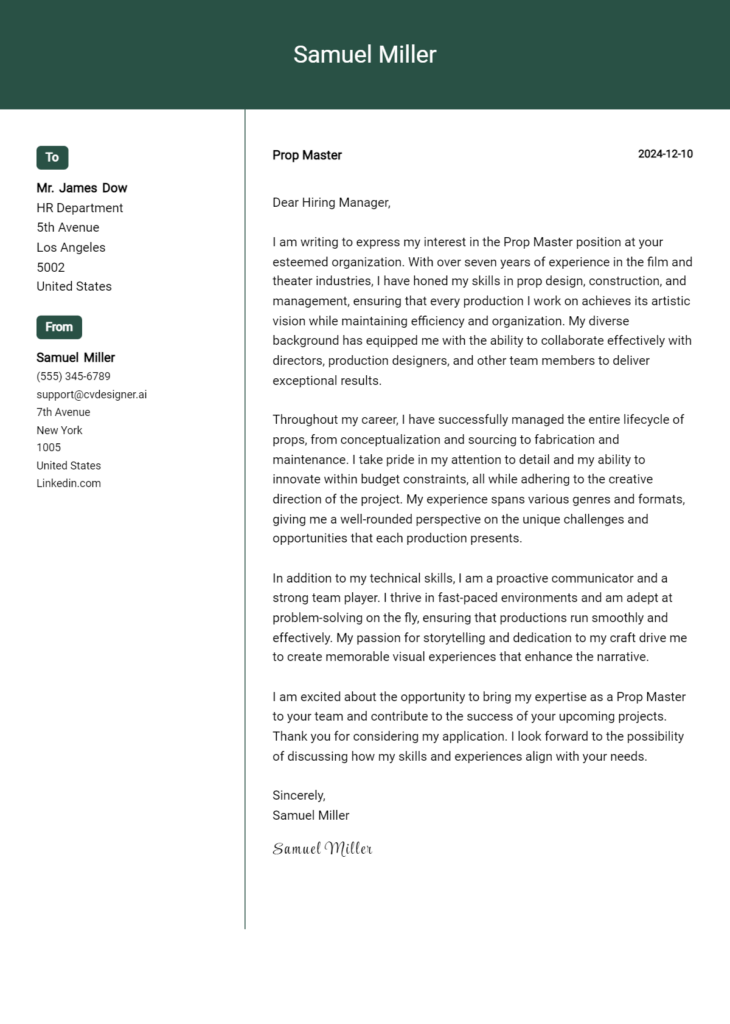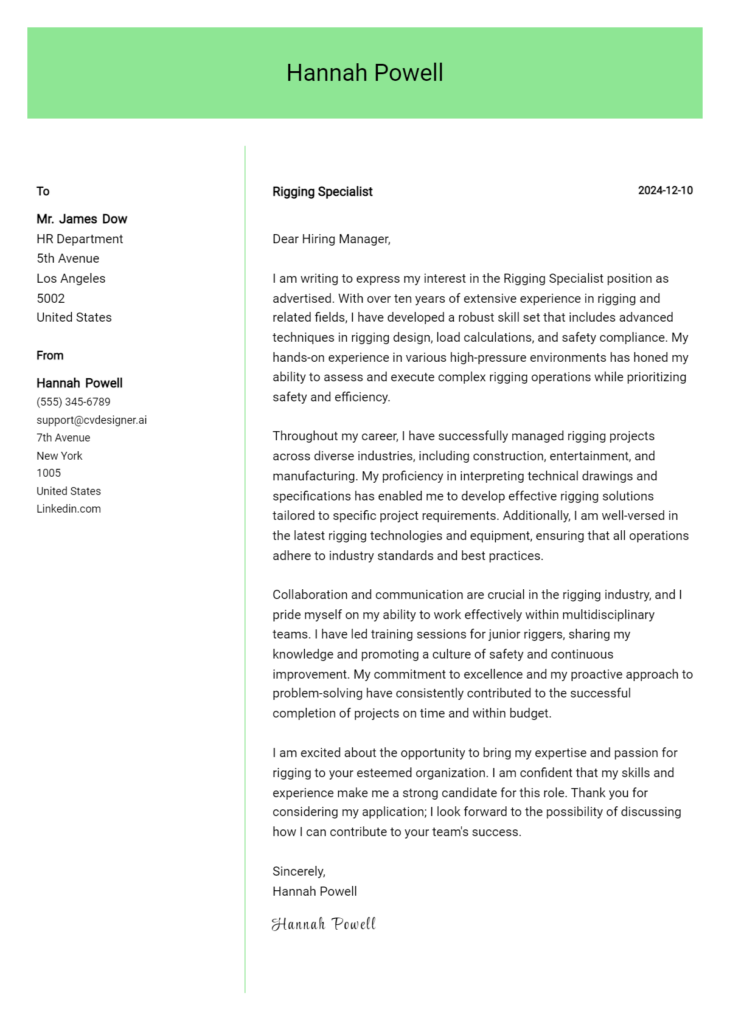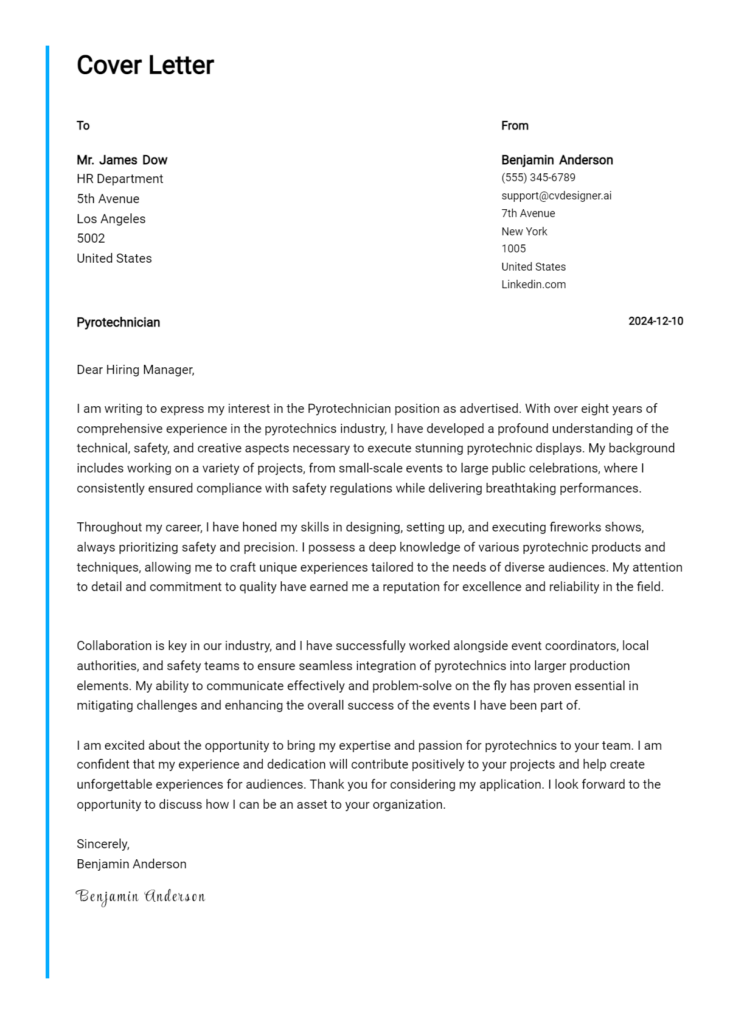Scenic Designer Cover Letter Examples
Explore additional Scenic Designer cover letter samples and guides and see what works for your level of experience or role.
How to Format a Scenic Designer Cover Letter?
Crafting an effective cover letter is essential for a Scenic Designer, as it serves as your first opportunity to showcase your creative vision and design philosophy to potential employers. Just as a well-designed set can transform a production, a meticulously formatted cover letter can leave a lasting impression on hiring managers. The structure of your cover letter not only highlights your artistic abilities but also demonstrates your organizational skills and attention to detail—qualities that are paramount in the world of scenic design.
In this guide, we’ll explore how to format your cover letter, providing specific insights and examples tailored for scenic designers to help you create a compelling document.
We will focus on the key components of a professional cover letter, including:
- Cover Letter Header
- Cover Letter Greeting
- Cover Letter Introduction
- Cover Letter Body
- Cover Letter Closing
Each section plays a crucial role in emphasizing your qualifications and creative flair. Let’s delve into each part and learn how to make your scenic designer cover letter shine.
Importance of the Cover Letter Header for a Scenic Designer
The cover letter header is a crucial element of your application as a Scenic Designer, as it sets the tone for the rest of your letter and provides essential information at a glance. A well-structured header enhances clarity and professionalism, ensuring that your application stands out. It should include your contact information, the date, and the recipient's details, allowing hiring managers to easily reach out to you. A polished header reflects your attention to detail—an important quality in scenic design.
Strong Example:
Jane Doe 123 Design Street New York, NY 10001 jane.doe@email.com (123) 456-7890 October 1, 2023 Mr. John Smith Artistic Director Theatre Company XYZ 456 Theatre Avenue New York, NY 10002
Weak Example:
jane doe email: jane.doe@email.com 123 design st nyc 10/1/23 theatre company
The Importance of the Cover Letter Greeting
The greeting of a cover letter serves as the initial point of contact between you and the hiring manager, setting the tone for the entire letter. A well-crafted greeting not only showcases your professionalism but also demonstrates a level of personalization that can make a strong impression. Addressing the hiring manager directly, when possible, shows that you have taken the time to research the company and its team, which reflects positively on your candidacy. To avoid generic greetings that can come off as impersonal, make an effort to find out the recipient's name through the company's website or LinkedIn. This small step can elevate your cover letter significantly.
Strong Greeting Example
Dear Ms. Johnson,
Weak Greeting Example
To Whom It May Concern,
The Importance of a Well-Crafted Cover Letter Introduction for a Scenic Designer
A well-crafted cover letter introduction is crucial for a Scenic Designer as it serves as the first impression to the hiring manager. This opening paragraph should not only capture their attention but also express genuine interest in the role while briefly showcasing key skills or notable achievements that make the candidate a strong fit. A compelling introduction can set the tone for the rest of the application, demonstrating creativity and passion—two essential qualities in scenic design. Below are examples of strong and weak cover letter introductions for a Scenic Designer position.
Strong Example
Dear [Hiring Manager's Name], As a passionate Scenic Designer with over seven years of experience in bringing theatrical visions to life, I was thrilled to discover the opening at [Company Name]. My work on productions such as "A Midsummer Night's Dream" and "Death of a Salesman" has not only garnered critical acclaim but has also deepened my love for creating immersive environments. I am eager to leverage my skills in conceptual design and collaboration to contribute to your innovative team and help elevate the storytelling experience for your audiences.
Weak Example
To whom it may concern, I saw that you have a job opening for a Scenic Designer. I have some experience in theater and like to work on sets. I think I could do the job. I hope you consider my application.
Purpose of the Cover Letter Body for a Scenic Designer
The body of a cover letter for a Scenic Designer serves as a crucial platform for candidates to articulate their unique blend of creativity, technical skills, and industry experience. It is an opportunity to highlight specific projects that demonstrate their ability to transform concepts into visually compelling designs. By showcasing notable accomplishments, such as collaborating on award-winning productions or successfully managing the design for a high-profile theater, candidates can effectively convey their value to the hiring company. This section should not only reflect the designer’s artistic vision and technical prowess but also align their work with the company’s goals, illustrating how they can contribute to the team.
Strong Example
Dear [Hiring Manager's Name], I am excited to apply for the Scenic Designer position at [Company Name]. With over five years of experience in the theater industry, I have successfully designed sets for productions such as "A Midsummer Night's Dream," which received the Best Set Design award at the [Specific Festival]. My approach combines innovative design techniques with a deep understanding of storytelling, allowing me to create immersive environments that captivate audiences. Additionally, my recent project, "The Glass Menagerie," involved collaborating with a talented director and a skilled team of artisans to bring the complex emotional landscape of the play to life through intricate set details and strategic lighting. I am eager to bring my passion and expertise in scenic design to [Company Name] and contribute to your team's future successes.
Weak Example
Dear [Hiring Manager's Name], I am writing to apply for the Scenic Designer role at [Company Name]. I have done some set design work before and think I would be a good fit. I worked on a few plays in college and helped with the scenery. I believe I can create nice-looking sets. I am interested in the company because it seems like a good place to work. I hope to bring my experience to your team and help with upcoming projects.
Importance of the Cover Letter Closing for a Scenic Designer
The closing paragraph of a cover letter is a crucial component for a Scenic Designer as it serves to summarize qualifications, express enthusiasm for the role, and encourage the hiring manager to take the next steps, such as reviewing the resume or scheduling an interview. A strong closing leaves a memorable impression, reinforcing the candidate's fit for the position and eagerness to contribute to the production. Conversely, a weak closing can diminish the impact of the entire application, making it less likely for the candidate to be considered.
Strong Example
Thank you for considering my application for the Scenic Designer position at XYZ Productions. With my extensive experience in creating immersive environments and my passion for storytelling through design, I am excited about the opportunity to contribute to your upcoming projects. I welcome the chance to discuss how my skills align with your vision and would be thrilled to schedule an interview at your earliest convenience. I look forward to the possibility of working together to create unforgettable theatrical experiences.
Weak Example
I hope you look at my resume. I'm not sure what else to say, but I think I could do the job. If you want to talk, you can call me or something. Thanks.
These tips will help candidates craft an effective cover letter for a Scenic Designer position by emphasizing the importance of showcasing technical skills, problem-solving abilities, knowledge of the scenic design life cycle (SDLC), teamwork, and a passion for continuous learning. A well-crafted cover letter not only highlights your qualifications but also reflects your enthusiasm for the role and the unique contributions you can bring to the team.
Tips for Writing a Cover Letter as a Scenic Designer
Highlight Technical Skills: Clearly outline your technical expertise in design software, such as AutoCAD, SketchUp, or Adobe Creative Suite. Mention any specific tools or technologies that are relevant to the position. This will demonstrate your readiness to tackle the technical demands of the job.
Showcase Problem-Solving Abilities: Provide examples of how you have successfully navigated challenges in past projects. Discuss any innovative solutions you implemented to overcome design constraints or logistical issues. This illustrates your critical thinking and adaptability, which are essential qualities for a Scenic Designer.
Demonstrate Knowledge of the Scenic Design Life Cycle (SDLC): Explain your familiarity with the various stages of scenic design, from concept development to execution. Mention any experiences where you collaborated with directors, production teams, and other stakeholders to bring a vision to life, showcasing your understanding of the entire process.
Emphasize Teamwork and Collaboration: Scenic design is often a collaborative process. Highlight your experience working in teams, whether in educational settings or professional environments. Describe how you communicate and collaborate effectively with others, which is crucial for ensuring a cohesive final product.
Express a Passion for Continuous Learning: The field of scenic design is constantly evolving with new techniques and technologies. Share your commitment to staying updated on industry trends and your willingness to learn new skills. Mention any relevant workshops, courses, or certifications you have pursued, demonstrating your proactive approach to professional development.
By following these tips and utilizing resources like cover letter templates or a cover letter builder, you can create a compelling cover letter that showcases your qualifications and enthusiasm for the role of Scenic Designer.
Common Mistakes to Avoid in a Scenic Designer Cover Letter
Crafting a compelling cover letter is essential for any Scenic Designer aiming to stand out in a competitive field. To enhance your chances of success, it's vital to avoid common pitfalls that can undermine your application. Here are several mistakes to watch for and tips on how to steer clear of them:
Generic Language: Using a one-size-fits-all approach can make your cover letter blend in with the rest. Tailor your letter to the specific role and company by incorporating relevant keywords and phrases from the job description.
Neglecting to Showcase Your Portfolio: Failing to mention or link to your portfolio can leave hiring managers wanting more. Always highlight specific projects and include links to your work to demonstrate your skills and creativity.
Poor Formatting: A cluttered or unprofessional format can detract from your message. Follow a clear cover letter format to ensure your letter is easy to read and visually appealing.
Lack of Enthusiasm: A cover letter that feels flat can signal a lack of passion for the role. Infuse your personality and excitement for the position to create a more engaging narrative.
Ignoring the Audience: Addressing your cover letter to a generic "Hiring Manager" can come off as impersonal. Research the organization and, if possible, address the letter to a specific individual.
Typos and Grammatical Errors: Mistakes can undermine your professionalism. Always proofread your letter multiple times or use tools to catch errors before submission.
Overly Long Content: A lengthy cover letter can lose the reader's interest. Aim for a concise yet impactful letter, ideally one page, that clearly conveys your qualifications and enthusiasm.
By avoiding these common mistakes and following effective strategies, you can craft a standout cover letter that showcases your talents as a Scenic Designer. For more inspiration, check out some cover letter examples to see how successful candidates present themselves.
Cover Letter FAQs for Scenic Designer
What should I include in my cover letter as a Scenic Designer?
Your cover letter should start with a strong introduction that captures your passion for scenic design and the specific position you are applying for. Highlight your relevant experience, including any notable productions you've worked on, and emphasize your unique skills, such as CAD proficiency or knowledge of sustainable materials. Mention any collaboration with directors and other designers, as teamwork is crucial in theater. Don’t forget to include your educational background, particularly if you have a degree in theater design or a related field. Finally, tailor your letter to the specific production or company, demonstrating your understanding of their aesthetic and mission.
How long should my cover letter be?
A cover letter for a Scenic Designer position should ideally be one page long, approximately 3-4 paragraphs. This length allows you to convey your qualifications and enthusiasm without overwhelming the reader. Each paragraph should serve a distinct purpose: an introduction that captures attention, a body that outlines your experience and skills, and a closing that reinforces your interest in the position. Be concise and to the point, ensuring that every sentence adds value to your application. Remember, hiring managers often review numerous applications, so clarity and brevity are key.
Should I address my cover letter to a specific person?
Whenever possible, addressing your cover letter to a specific person is highly recommended. This shows that you have done your research and are genuinely interested in the position. If you know the name of the hiring manager, director, or production designer, include it in your salutation. If you cannot find a name, consider using a general title, such as "Hiring Committee" or "Production Team." Avoid generic greetings like "To Whom It May Concern," as they can come across as impersonal. Taking the time to personalize your cover letter can help you stand out in a competitive field.
How can I demonstrate my creativity in my cover letter?
To showcase your creativity in your cover letter, use vivid language and imagery that reflects your design aesthetic. Instead of merely listing your skills, describe how you brought a unique vision to previous projects. For example, you might detail a particular scenic element you designed that enhanced the storytelling or transformed the stage. You can also discuss your design philosophy and how it aligns with the artistic goals of the company you're applying to. Including specific examples of challenges you faced and how you creatively solved them will also highlight your innovative thinking and problem-solving abilities, making your application memorable.
Build your Cover Letter in minutes
Use an AI-powered cover letter builder and have your letter done in 5 minutes. Just select your template and our software will guide you through the process.


